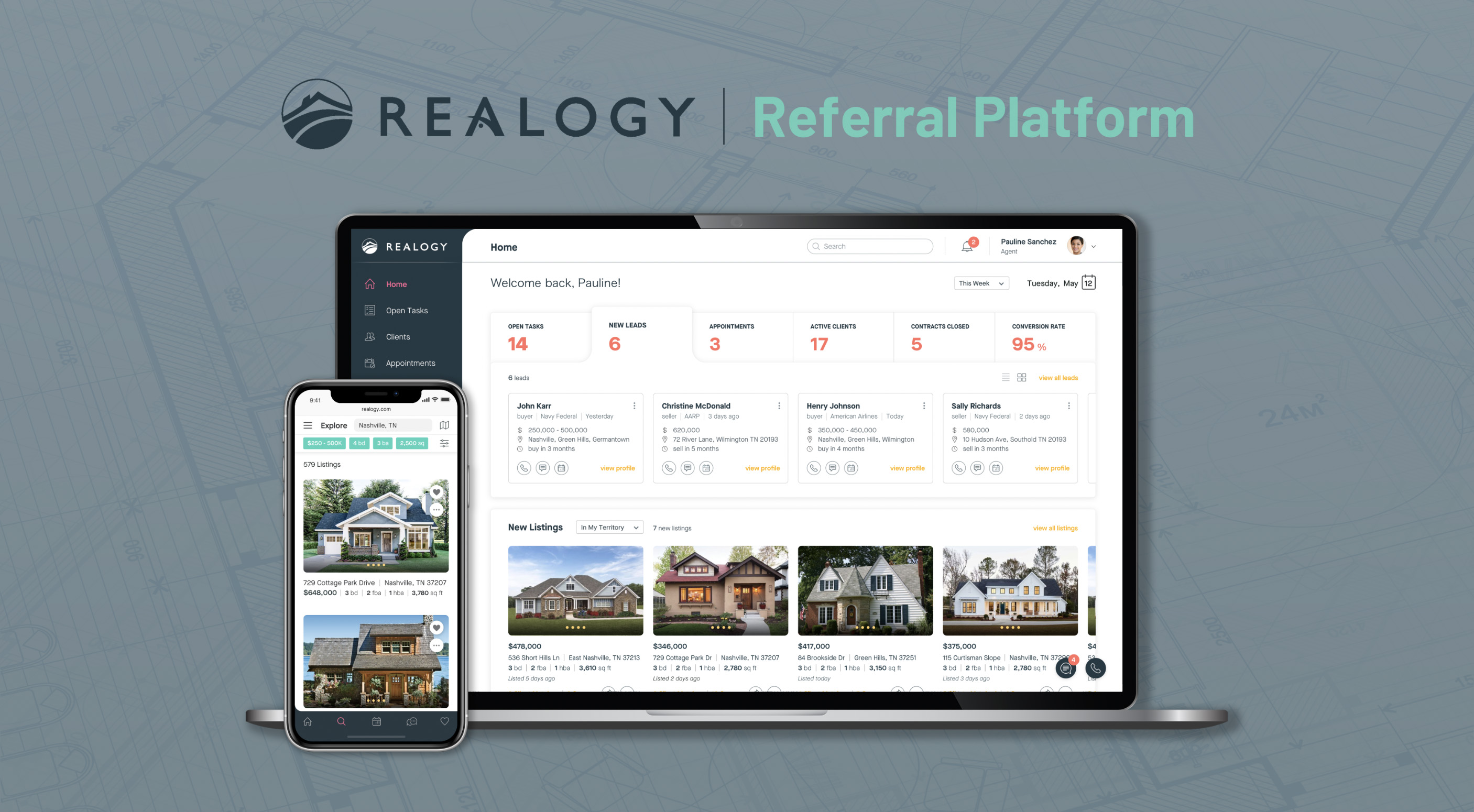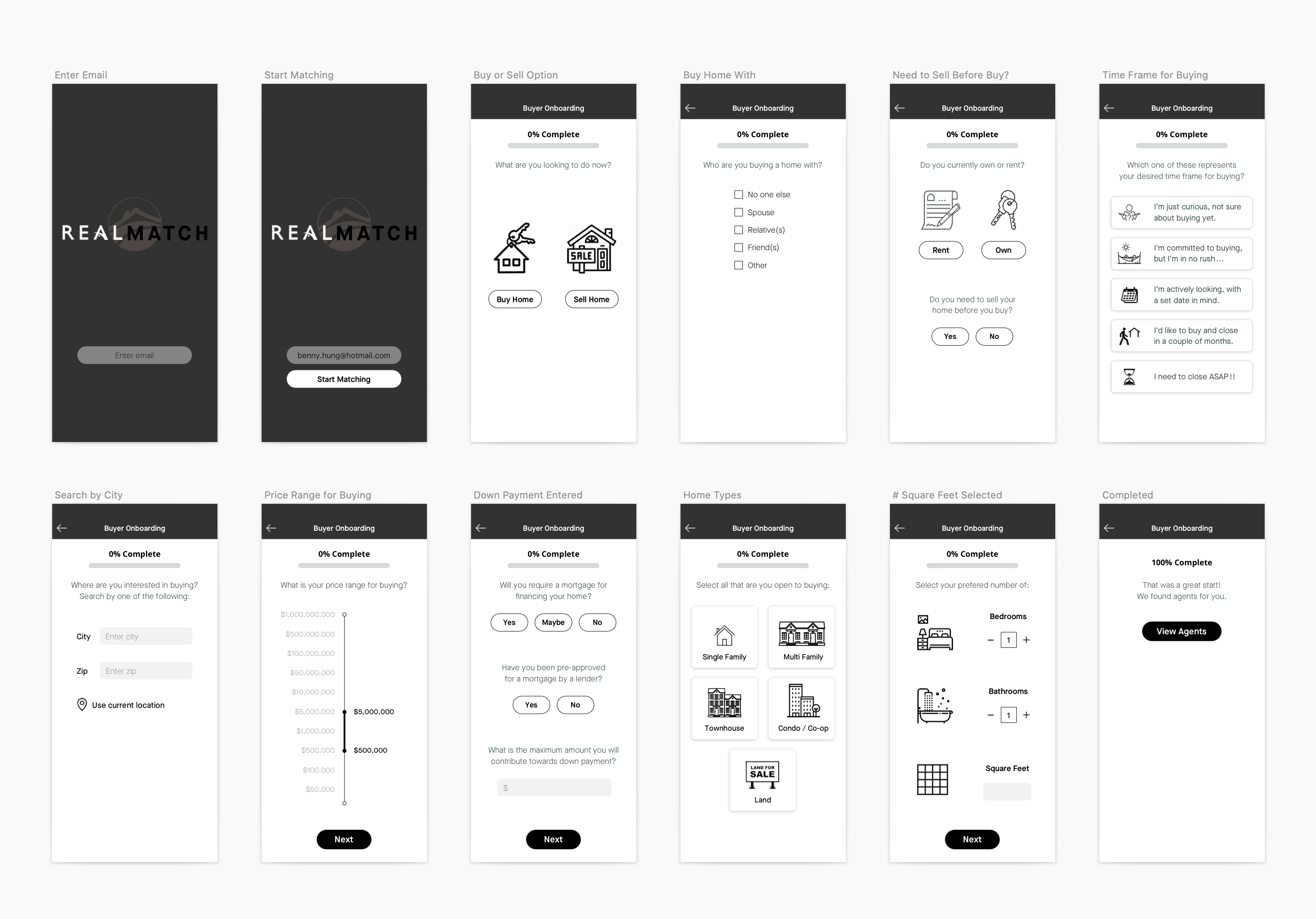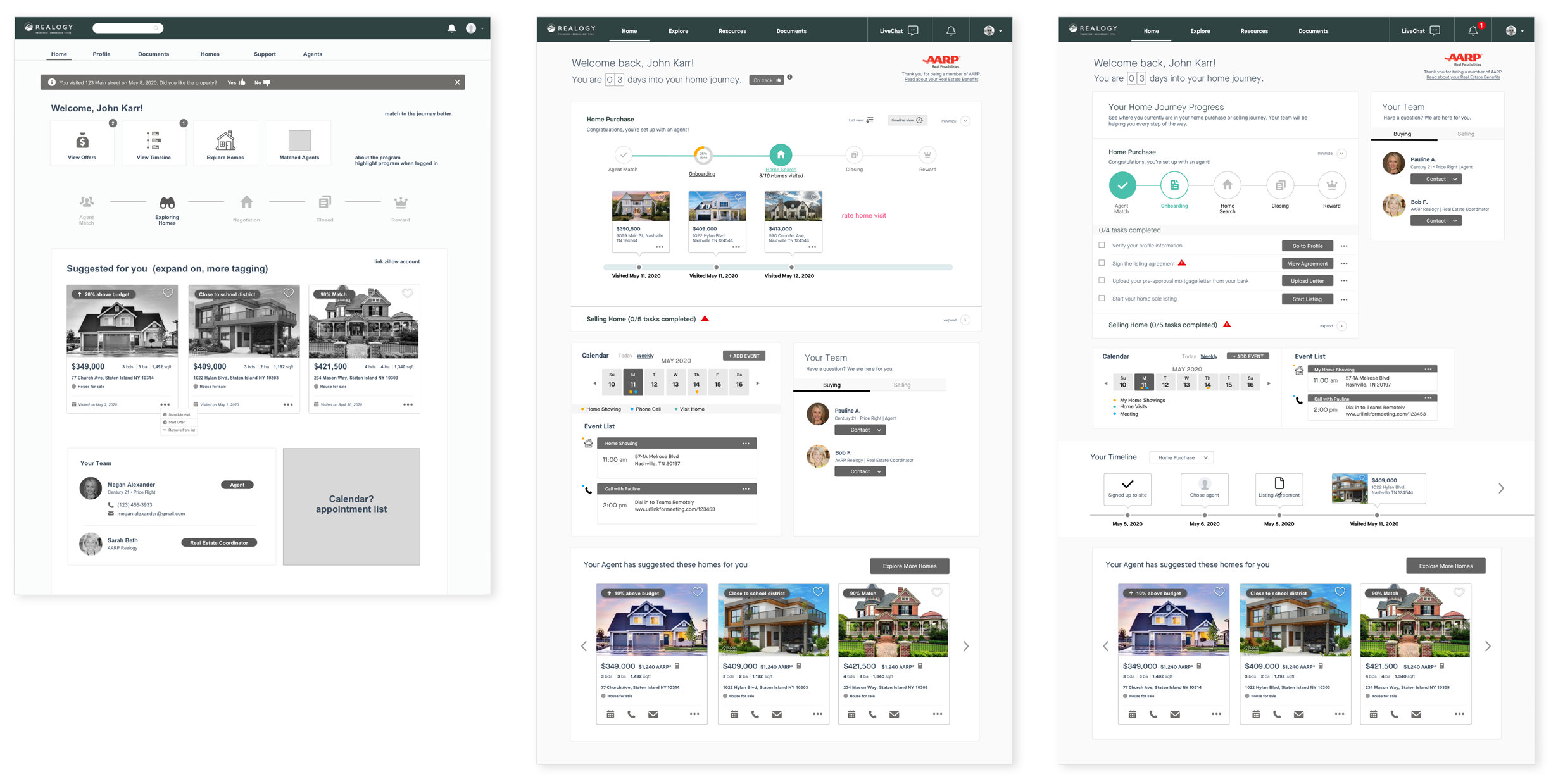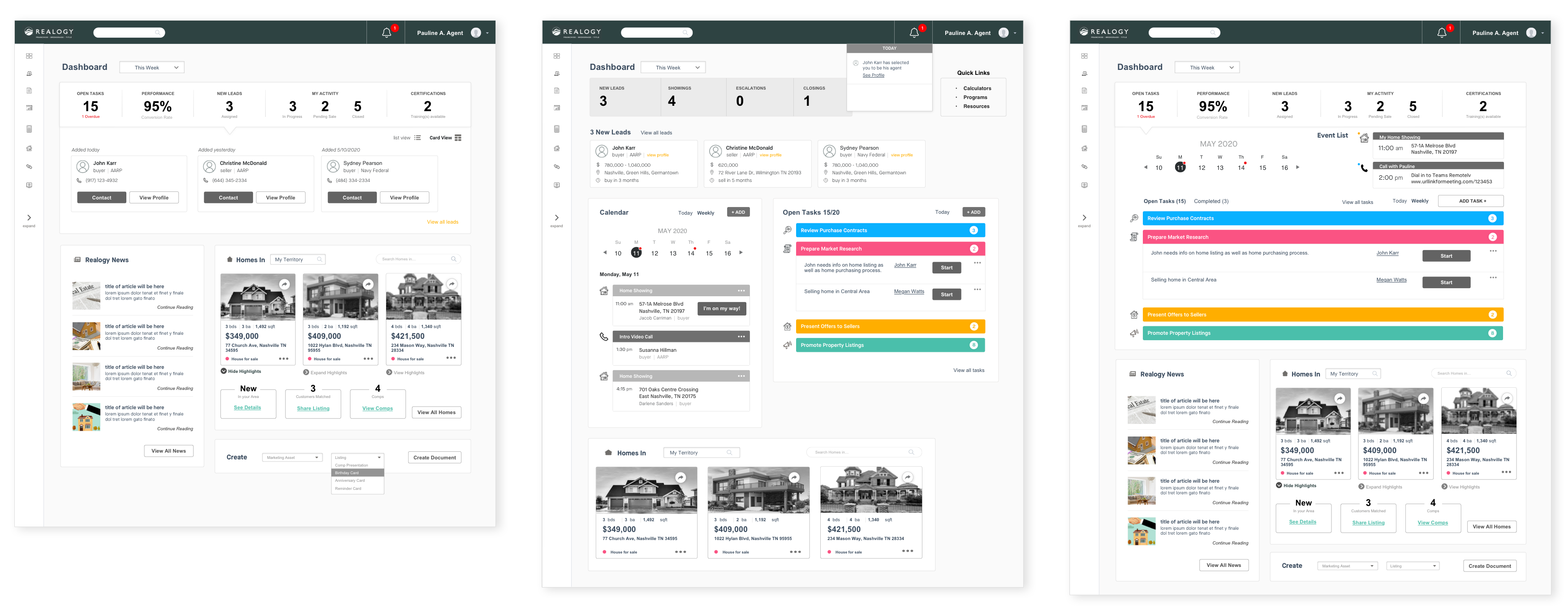

Realogy, the leading global real estate services firm, with subsidiary brands such as Century 21, Coldwell Banker, Corcoran, Sotheby's, Cartus, ERA, and Better Home & Gardens, hired my Mindtree team for the 9 week project "Referral Platform" to re-envision their website and mobile app interactions between home buyers, sellers, real estate agents, and coordinators.


Design Strategy With numerous design deliverables committed, I set timelines, product requirements, and delineated responsibilities between Kimberly (Mindtree designer) and myself.
Workshop Facilitation To obtain input from Realogy stakeholders, our team held numerous workshops (100% virtually), where we each led breakout sessions to moderate conversations between client groups.
UX Research I conducted over two dozen interviews and testing sessions to ideate, design, and validate prototypes with relevant user groups.
Product Design Lead I established the site architecture, information hierarchy, module features and functions, and interactive workflows for both desktop and mobile views, and consolidated Kimberly's low-fidelity wireframes and mine with a consistent design language.
UI & Art Direction I created the visual UI look and feel, set the typography and palette, and applied these elements throughout the prototypes.
In order for Realogy stakeholders to discuss objectives and align on scope and deliverables for this discovery project, we held frequent virtual meetings, workshops, and daily stand-ups to brainstorm and ideate, as shown in the Zoom call screenshot below. We also held smaller break-out groups for specialized discussions.


Our user research was based mainly on interviews. We worked with Realogy to identify a variety of agents, from different locations and diverse age groups. We also interviewed real estate coordinators, and spoke with home buyers and sellers. In total, we conducted over 20 interviews.
Each interview was approximately 45 minutes, and the intent was to understand users' professional needs, the psychology behind their behaviors, and their sentiment toward current work routines. We uncovered pain points in their current software, and identified opportunities to automate processes. Below is an example of my interview script, followed by notes taken via Mural app during interviews.

From these extensive interviews, Michael (Mindtree business consultant), Kimberly, and I compiled over 260 pain points, shaped personas ("Work-in-Progress Personas"), and Kimberly created the final persona deliverables ("Final Personas"), as shown below.

Besides hearing from Realogy stakeholders and respective user groups about their needs, I watched recorded demos of Realogy's existing software programs "Cartus Broker Network" and "e-Relocation", as shown in the screenshots below, to identify common workflows and opportunities for improvement.

Now that we identified client goals, gathered sufficient user research, and assessed existing software, our next step was to re-envision the experience. However, before my team would begin design execution, we wanted to get a feel for the Realogy stakeholders' ideas, since they were knowledgable about useful features, and were excited to be part of the creative process. We conducted virtual ideation sessions in breakout groups, and they made numerous product sketches, as shown below.

Customer Onboarding Enable customers to select their preferences and transition seamlessly into app.
Customer Selection of Agents Enable customers to view suitable agents' profiles, videos, and select them.
Customer Activity & Status Enable customers' buying/selling status and activity log to be shown.
Customer Sentiment Score Enable customers to have ongoing agent and coordinator satisfaction ratings.
Live Messaging & Calls Enable all personas to contact via mobile or desktop, and store messages in-app.
Automated Task Reminders Enable all personas to receive automated task notifications and specific CTAs.
Document Management Enable all personas to upload, send, view, sign, and share documents in-app.
3rd Party Calendar Synch Enable all personas to schedule and synch with multiple calendar platforms.
Integrated MLS Platform Enable in-app multiple listing service (MLS) for home buying and selling.
Agent's Recommendations Enable agents to recommend and share home listings to buyers in-app.
Using the feedback and ideas shared from the Realogy stakeholders, my team re-envisioned future state journeys for all personas. Caroline (Mindtree experience strategist) led the overarching story creation, and we collectively filled in customer, agent, and coordinator actions and touchpoints, as shown below.


We identified 5 journey phases: (1) Lead Source Onboarding, (2) Agent Selection, (3) House Hunting/Listing, (4) Offer, and (5) Closing. For this project engagement, Realogy stakeholders requested our focus on the first three workflows, which will be shown later on in the wireframe and prototype sections.
After creating future state journeys and obtaining validation from Realogy stakeholders, Michael (Mindtree business consultant) wrote user stories and application requirements, as shown below, in an excerpt of the 200-line requirements spreadsheet. I referenced this document to lead our product design and prototyping, ensuring all specified functions and features were accounted for.

By the fifth week in the 9 week Referral Platform project, we had completed client goals identification, existing platform analyses, pain points documentation, and requirements gathering. Since we were now entering the product design phase, I created and defined the prototype roadmap (as shown below), setting daily agenda, reviews schedule, and deliverable milestones.

Before Kimberly and I began wireframing, I recommended creating content maps so that we can collect all the necessary information for each screen. Once we have all the pieces identified, we could then focus on low-fidelity page layout and visual design. Below are examples of my content maps.

I led wireframing and protoyping creation, delineating persona screen designs between Kimberly and myself. I focused on customer and agent, while Kimberly on coordinator. We iterated quickly in low fidelity, and held frequent usability testing sessions with the respective persona groups. In order to show more screens for the same persona, we opted to show different workflows for mobile and desktop views.

My design for customer onboarding was meant to be straightforward, with fun imagery, quick and simple-to-answer questions, and a progress bar so customers would know how much more is needed for completion. I interviewed numerous customers to determine their comfort level in answering specific questions, and gauged how much information is needed by Realogy to determine appropriate agent matches. My initial questionnaire had 12 questions, but after further customer testing, I streamlined it to 8 steps. An interactive prototype is available in the next section.

The customer onboarding screens required tweaks, based on customer feedback on how much information about the agent they wanted displayed upfront. Most users preferred a bigger image of the agent. On the customer mobile and desktop home screens, the challenge was to display the same information on both formats; on earlier iterations, I led with "Notifications" or Open Tasks", but that prevented an initial snapshot of all pending items to be shown. Eventually, I was able to format the days to goal tracker, buying & selling status, notifications, Open Tasks, Appointments, and Recommended Listings on both platforms.

Kimberly and I required numerous iterations on this series of screens because we tested different placements of many in-demand modules that needed to be included. Based on feedback on customers' need to manage their buying and selling goals and timeframe, we included "Days Listed", "Days Left to Buy", and additional trackers on later iterations. Another particular challenge was displaying both customers' selling and buying status phases. The earlier approach of using a toggle system between selling and buying wasn't effective, as customers easily missed the non-active status. I addressed this issue in the final design by creating two separate modules, with their respective "Open Tasks" displayed. I also consolidated the customer's agent home recommendations and visit history within the same module for greater and more intuitive navigation.

Similar to the customer mobile home screen, I led with "New Leads" and "Tasks", but learned that presenting a consolidated number of items enabled agents to view all pending items at a quick initial glance. I started testing colors to differentiate task types and clients. However, the large areas covered by colors distracted from the actual content, so I kept the palette, but reduced its spread on the final screens. One important point agents mentioned was that they are mostly on the road, thereby rendering the mobile platform essential. They needed to quickly access their clients, so I displayed clients categorized in different buying and selling phases on the final design.

Based on the layout solution for the customer desktop screen, I reapplied the dual modules to the agent desktop for buying and selling phases and open task items. After several iterations, I captured all the immediate features agents wanted on the home dashboard, including access to resources. I also defined the default content on this screen, and placed easily accessible icons on the left nav for further features and functions.

Keeping in line with the tracking metrics on the agent and customer dashboards, "Chat Queue" and "Current Wait Time" are placed on the top. "Open Tasks" and viewing a list of customers are critical since the coordinator communicates frequently with buyers and sellers. Most of the features on this screen remained throughout all iterations, but were shuffled around. Kimberly worked exclusively on this screen before I finalized it in high fidelity.
After multiple design revisions and having reached alignment and testing validation with the respective personas, I integrated all wireframes cohesively, and designed mockups in higher fidelity with a unified look & feel. The final designs and high-fidelity prototypes for customer, agent, and coordinator are all done by me, and shown below.
Upon delivering all future state journeys and prototypes, the Realogy team was very pleased with the conceptual solution, which addresses the consolidation of multiple platforms into one, with in-app messaging, automated task notifications and activity log, MLS, and a document management system. Our business team is currently working with Realogy to plan a roadmap for developing our solution in phases, with an imminent MVP release. I will continue to post the latest on this ongoing rollout. Please stay tuned for updates!
